|
Click pictures for a larger version.
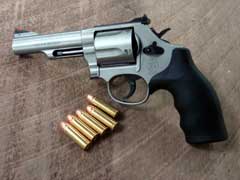
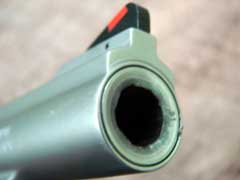
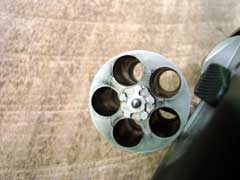

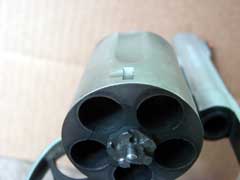
Bolt notches are placed between the chambers.
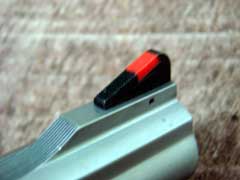
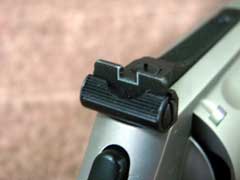

The top strap of the frame is drilled for a scope mount.

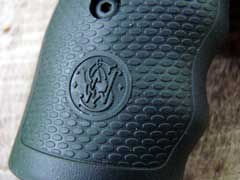

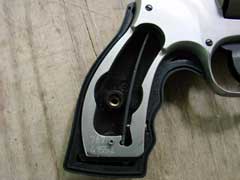
Synthetic rubber grips fit the author's hand very well.
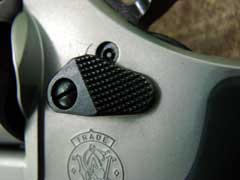
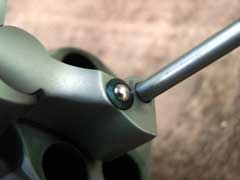
Ball locks crane into the rear of the barrel shroud.
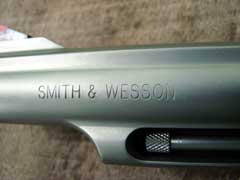
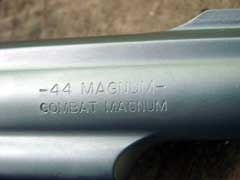
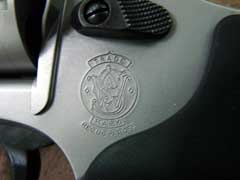
|
|
Smith
& Wesson has been in the revolver business for over one
hundred and fifty years now. Several times during that history,
"experts" have proclaimed that the revolver was
obsolete. While semi-automatic pistols are certainly more
popular these days, the revolver is far from being relegated to
the museum. Revolvers are still the weapon of choice in many
situations, and S&W continues to serve that market, with
many variations of their double-action design, chambered for
cartridges from the 22 Rimfires through
the big 500 S&W Magnum.
While
at the Media Day event preceding this
year's SHOT Show is Las Vegas, Nevada, S&W had at the
range two revolver introductions that piqued my interest. One
was the 929 9mm revolver, built primarily for competition, and
the other was the subject of this piece; the Model 69 five-shot
44 Magnum that is built on the L-frame platform. The L is sized
between the medium K and large N frame sizes, and was introduced
as a beefed-up six-shot duty gun in 357 Magnum back in 1980. The
Model 69 is the first 44 Magnum to be built on the L frame, and
is a bit more compact than the 629 six-shot 44 Magnum N-frame
revolver. The Model 69 is not the lightest 44 Magnum from Smith
& Wesson, which is the N-frame 329,
but the Model 69 fits that "just right" category
somewhere between the larger-but-lighter 329 and the heavier
629. The Model 69 is a full quarter-pound lighter than a
comparable Model 629, but most importantly, it is a bit smaller,
and the five-shot cylinder places the bolt notches between the
chambers, instead of directly over the chambers, which
effectively weakens the chamber wall.
The
Model 69 is built primarily of stainless steel, with black
screws, sights, grip, hammer, trigger, and cylinder latch
release, for an overall very good look. The stainless is
finished in a satin bead-blasted exterior. The rear sight is
adjustable for windage and elevation correction, and the black
serrated ramp front has a plastic red insert.
The firing pin is mounted in the frame, and the 69 has an
internal hammer-block safety, to prevent the weapon from firing
if dropped. There is also an internal lock that is activated by
a key inserted just above the cylinder latch release, if the
owner desires to use it. At no time during testing did the lock
activate while shooting. I have only experienced that on the
lightweight Model 329. Even while shooting Magnum 320 grain
loads, the Model 69 lock did not activate under recoil. The
Model 69 uses S&W's two-piece barrel design, with the actual
barrel inside of the outer shroud.
The
detailed specifications of the Model 69 are listed in the chart
below. All linear measurements are listed in inches, and the
weight is listed in ounces. The trigger pulls are listed in
pounds of resistance. SA is the single-action trigger pull. DA
is the double-action trigger pull. Height includes the sights.
| Weight |
36.6 ounces |
| Barrel Length |
4.23 inches |
| Trigger Pull SA |
4.1 pounds |
| Trigger Pull DA |
10.2 pounds |
| Cylinder Length |
1.682 inches |
| Cylinder Diameter |
1.56 inches |
| Chambers |
5 |
| Overall Length |
9.62 inches |
| Overall Height |
5.7 inches |
| Barrel / Cylinder Gap |
0.005 inch |
| Ammunition |
44 Magnum & 44
Special |
| MSRP as of June 6, 2014 |
$849 US |
I
fired the Model 69 for function using a variety of 44 Magnum and
44 Special ammunition. Velocity testing was done at a distance
of ten feet from the muzzle. Velocities were recorded at an
elevation of 541 feet above sea level, and are listed in
feet-per-second (fps). Velocity testing was done at a
temperature of eighty-two degrees Fahrenheit, with one hundred
percent humidity. I also tested the Model 69 for accuracy at a
distance of twenty-five yards, with the weapon secured into my Ransom
Master Series machine rest. Group sizes are measured
center-to-center of the two farthest-apart shots in each
five-shot group. Group sizes are the average of the groups
recorded with each type of ammo listed. Group sizes are listed
in the chart below, and are listed in inches. JHP is a jacketed
hollowpoint bullet. TAC-XP is a homogenous copper hollow point
bullet. LFN is a cast lead flatnose bullet. LHP is a lead
hollowpoint bullet. Bullet weights are listed in grains.
| Ammunition |
Bullet Weight |
Velocity |
Accuracy |
44 Magnum
|
|
|
|
| Buffalo Bore TAC-XP |
200 |
1476 |
1.60" |
| Buffalo Bore JHP |
180 |
1398 |
1.75" |
| Bruin LFP |
295 |
1203 |
2.63" |
| Cor-Bon JHP |
165 |
1271 |
2.05" |
| Cor-Bon LFN |
320 |
1145 |
2.75" |
44 Special
|
|
|
|
| Buffalo Bore LHP |
190 |
1077 |
2.20" |
| Federal LHP |
200 |
802 |
1.12" |
| Speer JHP |
200 |
683 |
2.60" |
| Buffalo Bore TAC-XP |
200 |
1023 |
1.90" |
As can be seen in the chart above, accuracy
was excellent with most loads tested, and superb with others.
Overall, I was very impressed by the accuracy of this Smith
& Wesson revolver. Also notable is the wide variation in the
velocities of the different brands of 44 Special ammunition. The
44 Special, properly loaded, is a very good cartridge for social
work or for hunting medium game.
The Buffalo Bore 44 Special
ammunition is very impressive, has low recoil, and offers
excellent performance. I particularly like the TAC-XP Lead-Free
stuff. In 44
magnum, again I like that same bullet for whitetail hunting, and
it is also a great choice for defense, when more velocity is
desired than is offered by the 44 Special ammunition. With
heavier bullets at magnum velocities, recoil is a lot stiffer
than with the 44 Special ammo, but the Model 69 is very
controllable, even with the 300 grain class of Magnum
ammunition.
Functioning of the Model 69 was flawless.
Every cartridge fired and ejected with a push of the extractor
rod. The 320 grain Cor-Bon ammo was a bit sticky on extraction,
but again, it ejected with the extractor rod. Primer
indentations were well-centered and positive, and as noted
above, recoil was easy to control, even with the hottest magnum
loads. The trigger pulls are as expected on a S&W revolver,
with a very smooth double-action and a crisp single-action pull.
The Model 69 carries very well, being more compact and lighter
than the larger Model 629, but still much more controllable than
the lightweight 329. The Model 69 is an ideal size for a hunting
gun when pursuing
whitetail and hogs, and it packs plenty of power to handle much
larger game, as well.
The Model 69 is in production now. Check out
the Model 69 and the extensive line of Smith & Wesson
firearms and accessories online at www.smith-wesson.com.
To
order quality 44 Magnum and 44 Special ammunition online, go to www.midsouthshooterssupply.com,
www.buffalobore.com, www.luckygunner.com,
and www.doubletapammo.com
Jeff Quinn
  
Got something to say about this article?
Want to agree (or disagree) with it? Click the following link to
go to the GUNBlast Feedback Page.
|
|
Click pictures for a larger version.
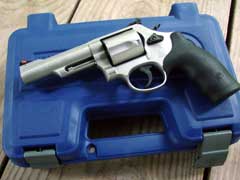
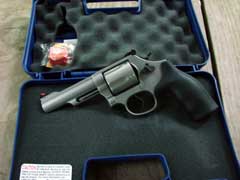
Smith & Wesson's Model 69 comes with a lockable hard case.
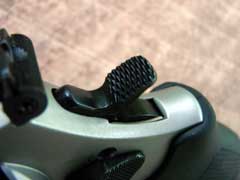
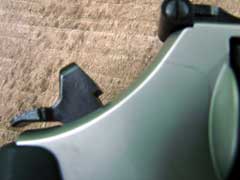
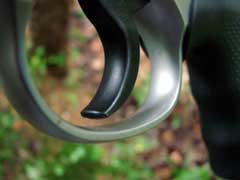

Internal key lock.
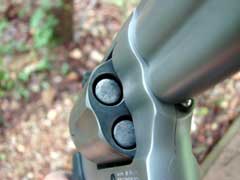
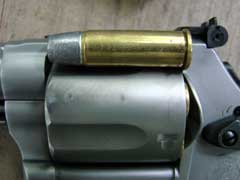
The cylinder has plenty of length to handle even the long 320-grain bullets.
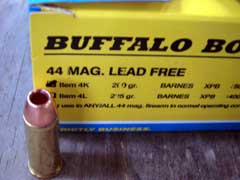
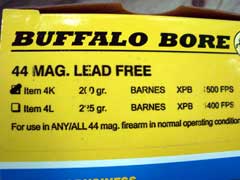
Buffalo Bore's Lead Free ammo is an excellent choice for hunting and social
work.
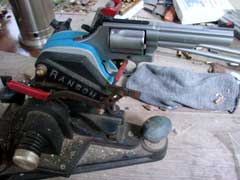
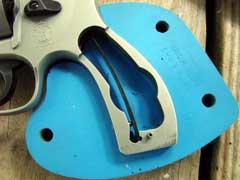
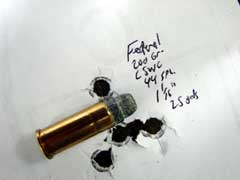
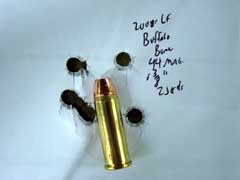
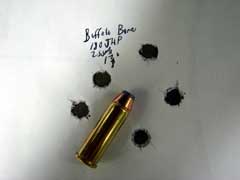
Accuracy testing was done at 25 yards from a Ransom Master Series machine
rest.
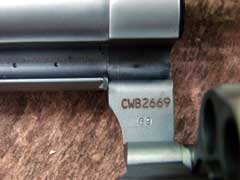
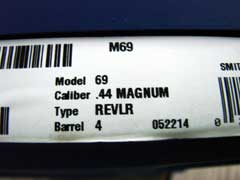
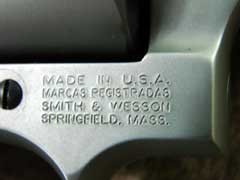
|
![]()